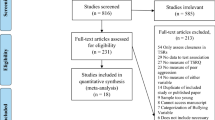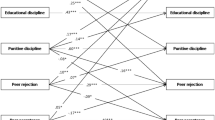Abstract
Although teachers are often called upon to reduce children’s bullying and aggression, little is known regarding teachers’ responses to students’ harassment of peers or the beliefs which may inform their response strategies. To address this limitation, data were collected from 170 6th- and 7th-grade teachers (33 men; 137 women) and 2,938 (1,413 girls; 1,525 boys) of their students. Teachers beliefs regarding peer victimization were predictive of their efforts to advice victims how to cope with peer harassment. In particular, teachers who held more normative views of peer victimization were less likely to report reprimanding aggressive students and were more likely to utilize passive response strategies. Specific links emerged between teachers’ beliefs and strategies and classroom-levels of aggression and peer victimization in the fall and in the spring, as well as changes in students’ aggressive behavior and victimization over the course of the school year. Implications for intervention are discussed.
Similar content being viewed by others
References
Abaied, J., & Rudolph, K. R. (2010). Parents as a resource in times of stress: interactive contributions of socialization of coping and stress to youth psychopathology. Journal of Abnormal Child Psychology, 38, 273–289.
Bauman, S., & Del Rio, A. (2006). Preservice teachers’ responses to bullying scenarios: comparing physical, verbal, and relational bullying. Journal of Educational Psychology, 98, 219–231.
Boivin, M., Hymel, S., & Bukowski, W. M. (1995). The roles of social withdrawal, peer rejection, and victimization by peers in predicting loneliness and depressed mood in childhood. Development and Psychopathology, 7, 765–785.
Borg, M. G., & Falzon, J. M. (1989). Primary school teachers’ perception of pupils’ undesirable behaviours. Educational Studies, 15, 251–260.
Boulton, M. J. (1997). Teachers’ Views on bullying: definitions, attitudes, and ability to cope. British Journal of Educational Psychology, 67, 223–233.
Boulton, M. J., & Underwood, K. (1992). Bully/victim problems among middle school children. British Journal of Educational Psychology, 62, 73–87.
Bryk, A. S., & Raudenbush, S. W. (1992). Hierarchical linear models: Applications and data analysis methods. Thousand Oaks: Sage.
Camodeca, M., Goossens, F. A., Schuengel, C., & Terwogt, M. M. (2003). Links between social informative processing in middle childhood and involvement in bullying. Aggressive Behavior, 29, 116–127.
Card, N. A., Stucky, B. D., Sawalani, G. M., & Little, T. D. (2008). Direct and indirect aggression during childhood and adolescence: a meta-analytic review of gender differences, intercorrelations, and relations to maladjustment. Child Development, 79, 1185–1229.
Craig, W. M., & Pepler, D. J. (2003). Identifying and targeting risk for involvement in bullying and victimization. Canadian Journal of Psychiatry, 48, 577–582.
Craig, W. M., Henderson, K., & Murphy, J. G. (2000a). Prospective teachers’ attitudes toward bullying and victimization. School Psychology International, 21, 5–21.
Craig, W. M., Pepler, D., & Atlas, R. (2000b). Observations of bullying in the playground and in the classroom. School Psychology International, 21, 22–36.
Crick, N. R., & Grotpeter, J. K. (1995). Relational aggression, gender, and social-psychological adjustment. Child Development, 66, 710–722.
Egan, S. K., & Perry, D. G. (1998). Does low self-regard invite victimization? Developmental Psychology, 34, 299–309.
Ellis, A. A., & Shute, R. (2007). Teacher responses to bullying in relation to moral orientation and seriousness of bullying. British Journal of Educational Psychology, 77, 649–663.
Frey, K. S., Hirschstein, M. K., Snell, J. L., Edstrom, L. V. S., MacKenzie, E. P., & Broderick, C. J. (2005). Reducing playground bullying and supporting beliefs: an experimental trial of the steps to respect program. Developmental Psychology, 41, 479–491.
Goldstein, N. E., Arnold, D. H., Rosenberg, J. L., Stowe, R. M., & Ortiz, C. (2001). Contagion of aggression in day care classrooms as a function of peer and teacher responses. Journal of Educational Psychology, 93, 708–719.
Helgeson, V. S. (1994). Relation of agency and communion to well-being: evidence and potential explanations. Psychological Bulletin, 116, 412–428.
Henry, D., Guerra, N., Huesmann, R., Tolan, P., VanAcker, R., & Eron, L. (2000). Normative influences on aggression in urban elementary school classrooms. American Journal of Community Psychology, 28, 59–81.
Hodges, E. V. E., Malone, M. J., & Perry, D. G. (1997). Individual risk and social risk as interacting determinants of victimization in the peer group. Developmental Psychology, 33, 1032–1039.
Howes, C., & Clements, D. (1994). Adult socialization in children’s play in child care. In G. Hillel & E. Vineberg Jacobs (Eds.), Children’s play in child care settings: SUNY series, children’s play in society (pp. 20–36). Albany: State University of New York Press.
Humphreys, A., & Smith, P. K. (1984). Rough-and-tumble in preschool and playground. In P. K. Smith (Ed.), Play in animals and humans (pp. 241–270). London: Blackwell.
Kärnä, A., Voeten, M., Poskiparta, E., & Salmivalli, C. (2010). Vulnerable children in varying classroom contexts: bystanders’ behaviors moderate the effects of risk factors on victimization. Merrill-Palmer Quarterly, 56, 261–282.
Kochenderfer, B. J., & Ladd, G. W. (1997). Victimized children’s responses to peers’ aggression: behaviors associated with reduces versus continued victimization. Development and Psychopathology, 9, 59–73.
Kochenderfer-Ladd, B., & Pelletier, M. E. (2008). Teachers’ Views and beliefs about bullying: influences on classroom management strategies and students’ coping with peer victimization. Journal of School Psychology, 46, 431–453.
Kochenderfer-Ladd, B., & Skinner, K. (2002). Children’s coping strategies: moderators of the effects of peer victimization? Developmental Psychology, 38, 267–278.
Moffitt, T. E. (1993). Adolescence-limited and life-course-persistent antisocial behavior: a developmental taxonomy. Psychological Review, 100, 674–701.
Nansel, T. R., Overpeck, M., Pilla, R. S., Ruan, W. J., Simons-Morton, B., & Scheidt, P. (2001). Bullying behaviors among US youth: prevalence and association with psychosocial adjustment. Journal of the American Medical Association, 285, 2094–2100.
Nicolaides, S., Toda, Y., & Smith, P. K. (2002). Knowledge and attitudes about school bullying in trainee teachers. British Journal of Educational Psychology, 72, 105–118.
O’Moore, M. (2000). Critical issues for teacher training to counter bullying and victimization in Ireland. Aggressive Behavior, 26, 96–111.
Olweus, D. (1991). Bully/victim problems among schoolchildren: Basic facts and effects of a school based intervention program. In D. J. Pepler & K. H. Rubin (Eds.), The development and treatment of childhood aggression (pp. 411–448). Hillsdale: Lawrence Erlbaum Associates, Inc.
Olweus, D. (1993). Bullies on the playground. The role of victimization. In C. Hart (Ed.), Children on the playground: Research perspectives and applications (pp. 85–128). New York: SUNY Press.
Olweus Bullying Prevention Program (2013). Violence Prevention Works! Retrieved September 29, 2013 from: http://violencepreventionworks.org.
Paquette, J. A., & Underwood, M. K. (1999). Gender differences in young adolescents’ experiences of peer victimization: social and physical aggression. Merrill-Palmer Quarterly, 45, 242–266.
Pellegrini, A. D. (2003). Perceptions and functions of play and real fighting in early adolescence. Child Development, 74, 1522–1533.
Pellegrini, A. D., & Long, J. D. (2002). A longitudinal study of bullying, dominance, and victimization during the transition from primary school through secondary school. British Journal of Developmental Psychology, 20, 259–280.
Pepler, D. J., Craig, W. M., Ziegler, S., & Charach, A. (1994). An evaluation of an anti-bullying intervention in Toronto schools. Canadian Journal of Community Mental Health, 13, 95–110.
Raudenbush, S. W., & Bryk, A. S. (2002). Hierarchical linear models: Applications and data analysis methods (2nd ed.). Newbury Park: Sage.
Rose, A. J., & Rudolph, K. D. (2006). A review of sex differences in peer relationship processes: potential trade-offs for the emotional and behavioral development of girls and boys. Psychological Bulletin, 132, 98–131.
Salmivalli, C., Karhunen, J., & Lagerspetz, K. M. J. (1996). How do victims respond to bullying? Aggressive Behavior, 22, 99–109.
Sandstrom, M. J. (2004). Pitfalls of the peer world: how children cope with common rejection experiences. Journal of Abnormal Child Psychology, 32, 67–81.
Schwartz, D., Dodge, K. A., & Coie, J. D. (1993). The emergence of chronic peer victimization in boys’ play groups. Child Development, 64, 1755–1772.
Shavelson, R., & Stern, P. (1981). Research on teachers’ pedagogical thoughts, judgments, decisions, and behavior. Review of Educational Research, 51, 455–498.
Smith, P. K., & Sharp, S. (1994). School bullying: Insights and perspectives. London: Routledge.
Spence, J. T., & Buckner, C. E. (2000). Instrumental and expressive traits, trait stereotypes, and sexist attitudes. Psychology of Women Quarterly, 24, 44–62.
Stephenson, P., & Smith, D. (1989). Bullying in the junior high. In D. P. Tattum & D. A. Lane (Eds.), Bullying in schools (pp. 45–47). Stoke-on-Trent: Trentham.
Stormshak, E. A., Bierman, K. L., Bruschi, C., Dodge, K. A., & Coie, J. D. (1999). The relation between behavior problems and peer preference in different classroom contexts. Child Development, 70, 169–182.
Tapper, K., & Boulton, M. J. (2005). Victim and peer group responses to different forms of aggression among primary school children. Aggressive Behavior, 31, 238–253.
Troop-Gordon, W., & Kopp, W. (2011). Teacher-child relationship quality and children’s peer victimization and aggressive behavior in late childhood. Social Development, 20, 536–561.
US Department of Health and Human Services. (2013). Stop Bullying. Retrieved September 29, 2013 from: http://stopbullying.gov.
Zimmer-Gembeck, M. J., Geiger, T. C., & Crick, N. R. (2005). Relational and physical aggression, prosocial behavior, and peer relations: gender moderation and bidirectional associations. Journal of Early Adolescence, 25, 421–452.
Acknowledgments
Portions of this study were conducted as part of the Pathways Project, a larger longitudinal investigation of children’s social/psychological/scholastic adjustment in school contexts that is supported by the National Institutes of Health (1 RO1MH-49223, 2-RO1MH-49223, R01HD-045906 to Gary W. Ladd). Special appreciation is expressed to all the children and parents who made this study possible, and to members of the Pathways Project for assistance with data collection.
Author information
Authors and Affiliations
Corresponding author
Appendix
Appendix
Rights and permissions
About this article
Cite this article
Troop-Gordon, W., Ladd, G.W. Teachers’ Victimization-Related Beliefs and Strategies: Associations with Students’ Aggressive Behavior and Peer Victimization. J Abnorm Child Psychol 43, 45–60 (2015). https://doi.org/10.1007/s10802-013-9840-y
Published:
Issue Date:
DOI: https://doi.org/10.1007/s10802-013-9840-y




